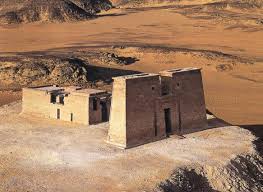The Dekkah Temple is located about 100 kilometers south of Aswan High Dam in the Historical Nubia. It was moved to the site of el-Sebua, about 40 kilometers upstream, between 1962 and 1968, to protect it from the waters of Nasser Lake. The first works in the temple date back to the reigns of Hatshepsut and Tutmosis III, with aggregations of Nubian king, Akamani. But the actual building dates back to Ptolemy II Philadelphus.
The pylon of the temple is now separated from the remainder of the temple due to the missing enclosure walls of the open court. On the southern side of the temple, a small entrance leads into the interior of the pylon and to a stairway that communicates with several internal rooms. After the open courtyard, the facade of the pronaosis has reliefs depicting the King making offerings to various deities. The temple has two sanctuaries, one built by Arkamani and the second was added by Augustus. The temple was converted into a church by early Christians. In the neighborhood, the tourist can visit the temple of el-Sebua and the Temple of Maharraka from the Roman Era.

